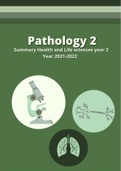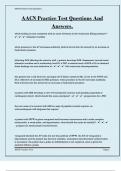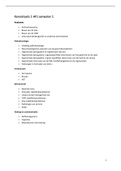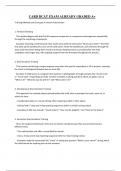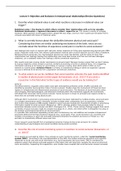, Index
Index 2
Chapter 1. Pathology of the digestive tract 3
Chapter 2. The lung 6
Chapter 3. The hematopoietic and lymphoid systems 11
Chapter 4. Cardiovascular pathology 15
Chapter 5. The female genital system 20
Chapter 6. The nervous system 25
Chapter 7. Neurodegeneration 30
Pagina 2 van 33
,Chapter 1. Pathology of the digestive tract
A normal esophagus (in dutch: slokdarm) is characterized by a Z-line:
this is the junction before the stomach. The esophagus has different
layers, just like the intestines and stomach.
The esophagus is lined with squamous epithelium. So squamous
epithelium is the most outer side. Right after, there is the lamina propria
and muscularis mucosa. These three layers form the mucosa!!
Submucosa, consist of a circular muscular layer and a longitudinal muscular layer. Last,
adventitia (composed of mainly fatty tissue).
Squamous epithelium changes on the basal layer
-> stem cells are dividing -> proliferation. They
migrate towards the surface and fall off.
Esophageal carcinoma -> two important types
• Main type: adenocarcinoma (=Barrett carcinoma) ->
there are four steps which will lead to adenocarcinoma:
1. Esophagitis -> inflammation: hyperemia, granulocytes
and in severe cases ulceration.
2. Intestinal metaplasia and (chronic) inflammation ->
metaplasia = replacement of a differentiated cell type by
another differentiated cell type.
3. Dysplasia -> cytonuclear atypia. These are large
nuclei, which have an irregular shape and coarse
chromatin pattern. Dysplasia is the picture with the yellow
line.
4. Adenocarcinoma. Adenocarcinoma is the picture with
the red line. In dutch: ontstaat door reflux van de maag ->
inflammatie oesophagus.
• Other type: squamous cell carcinoma. This is showed
on the picture with the blue line. On the left, there is a
normal situation of squamous cells. On the right, you’ll
see dysplasia.
Again, dysplasia: precancerous stage. Greater nuclei,
irregular shape and more cells. There is no infiltration in
deeper sides.
Pagina 3 van 33
, Stomach
Gastric mucosa histology:
• Foveolar layer -> mucus cells are present and produce mucus
• Glandular layer -> many different cells, the most important ones are
the parietal cells (acid and intrinsic factor). Are only present in the
corpus, not in the antrum! In the antrum, hormone-producing cells like
gastrin are produced.
• Smooth muscle -> chief cells which produces pepsinogen. Also
enterochromaffin-like cells which produces histamine, and hormone-
producing cells which produces for example somatostatin.
Inflammation of the gastric mucosa (gastritis)
• Acute gastritis
Causes: H. Pylori, alcohol, NSAID. H. Pylori is showed here ->
• Auto-immune gastritis
• Others -> granulomatous gastritis, Crohn’s disease,
lymphocytic gastritis.
Auto-immune gastritis
-Antibodies against parietal cells and intrinsic factor
-Intestinal metaplasia
-Neuro-endocrine cell hyperplasia
-Anemia
-Increased risk for adenocarcinoma
-Increased risk for neuro-endocrine tumor
Normal mucosa -> chronic gastritis -> intestinal metaplasia -> dysplasia ->
gastric adenocarcinoma. Due to morphological changes and genomic
changes. Intestinal metaplasia to adenocarcinoma is due to genomic
changes (so, the last three steps).
Different types of gastric adenocarcinoma
1. Intestinal type adenocarcinoma
2. Diffuse type adenocarcinoma -> it’s everywhere not at just one place.
Worse prognosis compared to the intestinal type.
Lower digestive tract
Colorectal cancer development
Gastrointestinal (GI) tumors comprise 27% of all cancer related mortality. There is an high
incidence and a poor prognosis when present in late stage of disease.
Pagina 4 van 33



